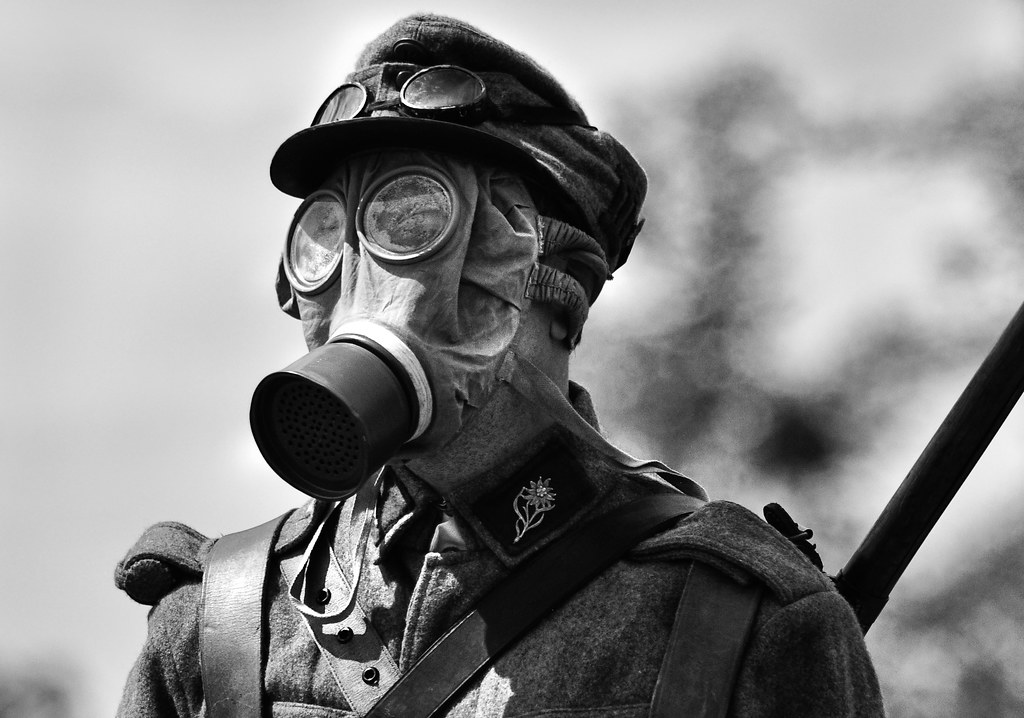

As the majority of transport in every army during WW1 was horse or mule transport, then these animals became. After reactivating the adhesive with small amounts of isopropanol or acetone in liquid form, the lining was applied to the interior of the facemask in sections, which allowed for greater control and safer handling. Posts about Gas Mask written by sommecourt. Soldier has green uniform with a rounded green helmet and green. To prepare the lining for the facemask, a large piece of Hollytex was pre-toned with Golden fluid acrylic paints, and the 1:1 Lascaux 498HV:Lascaux 303HV mixture was evenly brushed on and allowed to dry. Pair of WWI German soldiers wearing gas masks and advancing with bayonets (a,b). At first, soldiers held chemically treated cotton pads over their noses and. So, quickly, both sides developed gas masks. Instead of riding around on horses freely, soldiers had to use protection in order to evade the deadly chemicals. Mylar (biaxially oriented polyethylene terephthalate film) Not only did poisonous gas change the experiences of war, but also the type of warfare. And it wasn’t just human combatants who suffered many military working animals. Lascaux 303HV (aqueous dispersion of butyl acrylate and methylmethacrylate thickened with acrylic butylester, replaces Lascaux 360HV) During World War I, more than 90,000 soldiers died on all sides from gas attacks, which debilitated many more.

Lascaux 498HV (aqueous dispersion of butyl acrylate and methylmethacrylate thickened with acrylic butylester) Hollytex (spun bonded polyester with a calendared surface) Golden Fluid Acrylic colors (low-viscosity acrylic paints with a high pigment load) Oh, they were a nuisance, but that was the first gas mask that came in.Acrylic Sheet Backer Rod (cylindrical polyethylene foam) And you had two goggles here on to look out, two glasses to look out and with your breath it didn't take long before the glasses were steamed up and you couldn't see where you were going. Well then they got this, the improved type. The chemical was pretty near as bad as the gas. It was something like flannelette, wool serge would probably better describe it. You respired through this heavily, heavy material. They say necessity is the mother of invention. soldiers model international World War I gas mask designs. You inhaled through your nose and respired through your mouth. Troops Made Masks Soaked In Their Own Urine And You Have To Know Why. The old one we had first, you pulled it over your head like a balaclava. I remember the old one, the one that this was a respirator, you know, one that you clamped on your head with an elastic. I remember one night, some of our fellas put them on when we come to a dead horse, that was the only reason. I don't remember ever putting my gas mask on. If you hadn't used it then you wouldn't mark anything on this. Browse a wide selection of ww1 gas mask and face coverings available in various fabrics and configurations, made by a community of small business-owners. Why did German soldiers wear gas masks Having learned from the chemical warfare of WWI, however, Germany wanted to keep its army protected against chemical warfare. Sometimes referred to as model 1917, after the year of its. What gas masks were used in WW1 One of the most notable gas masks used during WW1 was the British Small Box Respirator or SBR designed in 1916 and the German GM-15 mask. Every time you used your respirator you were supposed to mark how long you had it on, if you used it. The Germans used both leather leder and rubber gummi masks during the First World War. This gas mask was part of the field gear used in WWI by a soldier in the 369th Infantry, an African-American regiment known as the Harlem Hellfighters. The gas officer would always, when you had your staff parade in the morning, he would test your, he would look at your respirators and you had to have that ticket, the little ticket. MacLeod gives a good comparison between the original respirator and newer gas masks used by Canadian soldiers. The first use of chemical warfare was on April 22 1915, when Germany released chlorine. However, the masks could not protect them against mustard gas used later in the war, which burned the skin, caused severe breathing problems, and could cause blindness. Gas masks on a British soldier and a horse during the First World War. Allied troops were given gas masks to protect against chlorine gas attacks.


 0 kommentar(er)
0 kommentar(er)
